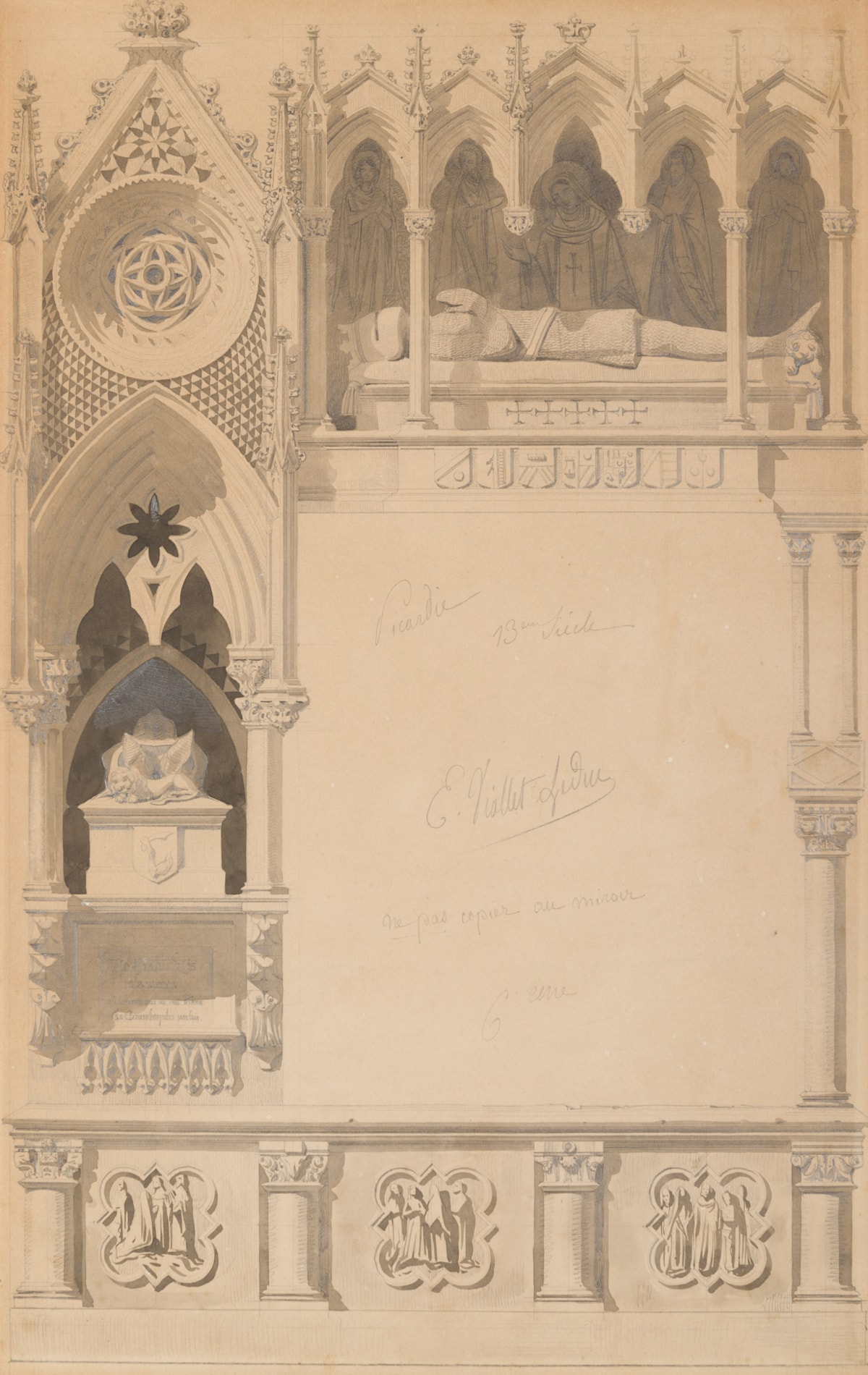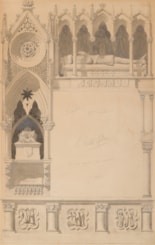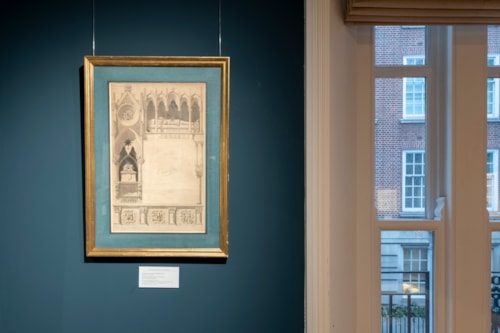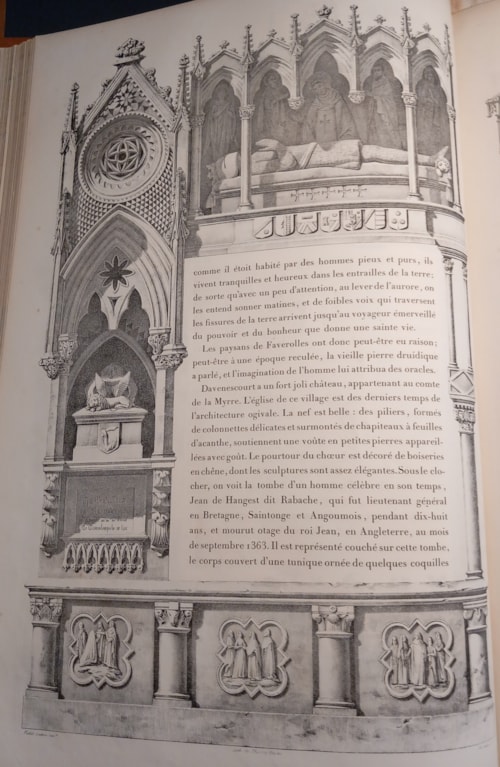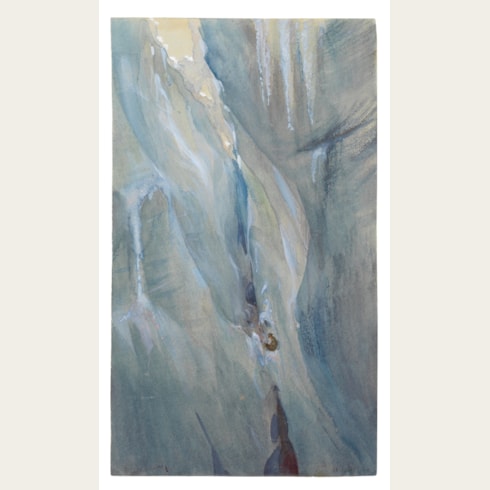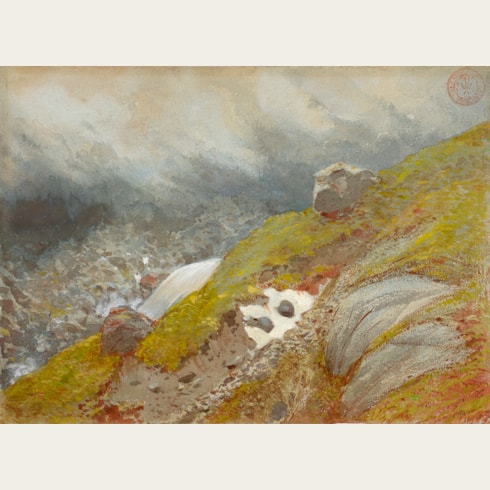Eugène Emmanuel VIOLLET-LE-DUC
(Paris 1814 - Lausanne 1879)
Studies of a Gothic Monument in Picardy, with the Tomb of a Knight
Pencil and two shades of grey wash.
Inscribed and signed Picardie / 13eme Siècle / E. Viollet Leduc / ne pas copier au miroir / 6 eme in pencil in the centre of the sheet.
463 x 293 mm. (18 1/4 x 11 1/2 in.)
Inscribed and signed Picardie / 13eme Siècle / E. Viollet Leduc / ne pas copier au miroir / 6 eme in pencil in the centre of the sheet.
463 x 293 mm. (18 1/4 x 11 1/2 in.)
This large drawing by Viollet-le Duc is a preparatory study for one of the full-page framing illustrations in the volume of Baron Taylor’s Voyages pittoresques et romantiques dans l’ancienne France devoted to the region of Picardy, published in instalments between 1835 and 1845. The monumental publication of the Voyages pittoresques et romantiques dans l’ancienne France, illustrating the architectural and artistic heritage of the various regions of France, was issued in twenty-four volumes between 1820 and 1878. The text was the work of various authors and the accompanying illustrations were commissioned from several artists, notably Viollet-le-Duc, who produced over 220 of them for the book.
As one modern scholar has noted of his work for the Voyages pittoresques et romantiques, ‘The invention that went into these astonishing specimens of the current medievalizing mania is striking, giving them a special quality that Baron Isidore Justin Séverin Taylor recognized. These ornamental exercises testify in great measure to Viollet-le-Duc’s unrestrained love for decoration, a type of work he considered “truly artistic”, and likewise the nature of his relationship with the Middle Ages, a world he believed to have been bursting with vitality. What distinguished his decorative borders from those of others was not only the inventive nature of the compositions, but also the choice of subject.’ This particular page is found twice in the Voyages pittoresques et romantiques dans l’ancienne France.
A number of other drawings for the same work are in the extensive collection of drawings by Viollet-le-Duc in the Médiathèque du Patrimoine et de la Photographie (Centre de Recherches sur les Monuments Historiques) in Charenton-le-Pont.
As one modern scholar has noted of his work for the Voyages pittoresques et romantiques, ‘The invention that went into these astonishing specimens of the current medievalizing mania is striking, giving them a special quality that Baron Isidore Justin Séverin Taylor recognized. These ornamental exercises testify in great measure to Viollet-le-Duc’s unrestrained love for decoration, a type of work he considered “truly artistic”, and likewise the nature of his relationship with the Middle Ages, a world he believed to have been bursting with vitality. What distinguished his decorative borders from those of others was not only the inventive nature of the compositions, but also the choice of subject.’ This particular page is found twice in the Voyages pittoresques et romantiques dans l’ancienne France.
A number of other drawings for the same work are in the extensive collection of drawings by Viollet-le-Duc in the Médiathèque du Patrimoine et de la Photographie (Centre de Recherches sur les Monuments Historiques) in Charenton-le-Pont.
An architect and restorer of medieval buildings, as well as a painter, watercolourist and illustrator, Eugène Viollet-le-Duc is best known for his reconstruction and renovation of Gothic buildings and churches throughout France. Although he decided at an early age to become an architect, he chose not to follow the usual path of studying at the Ecole des Beaux-Arts in Paris, preferring instead to apprentice with the architects Jean-Jacques-Marie Huvé and François-René Leclère. He also travelled extensively around France, visiting the Auvergne, Provence, Normandy, the Pyrenées and Languedoc, as well spending several months in Italy. He taught at the Ecole de Dessin in Paris, and between 1837 and 1844 contributed some 250 illustrations for Baron Taylor, Charles Nodier and Alphonse de Cailleux’s monumental Voyages pittoresques et romantiques dans l’ancienne France, published in twenty-four volumes between 1820 and 1878.
In 1838 Viollet-le-Duc began working for the Conseil des Bâtiments Civils, which supervised work on buildings belonging to the State, and in particular the restoration of national monuments. Through the intervention of Prosper Merimée at the Commission des Monuments Historiques, he was commissioned to take charge of the restoration of the Romanesque abbey of Sainte-Marie-Madeleine at Vézelay in 1840. This was the first of several major renovation projects that Viollet-le-Duc was closely involved in, among the most significant being the restoration of Sainte-Chapelle and Notre-Dame in Paris, the abbey of Saint-Denis and the cathedrals of Amiens, Reims and Clermont-Ferrand, as well as the walls of Carcassonne and Avignon.
Viollet-le-Duc’s close study of Gothic architecture led to an interest in stained glass production, and between 1840 and 1847 he provided designs for stained glass windows for the Sèvres porcelain factory, while also designing liturgical objects and furnishings in a Gothic Revival style for many of the churches where he worked. He was perhaps equally as important as a theorist, and his writings had a significant impact on the understanding and appreciation of medieval architecture, and were an influence on the 19th century practice of architectural restoration. Much of his subsequent fame also rests on his seminal Dictionnaire raisonné de l’architecture française du XIe au XVIe siècle, published in ten volumes between 1854 and 1868 and a highly influential work among such later architects as Antoni Gaudí and Victor Horta.
Other important studies authored by Viollet-le-Duc include a comprehensive study of medieval and Renaissance furniture, jewellery, armour, clothing, musical instruments and interior decoration in France, published between 1858 and 1875 as the Dictionnaire raisonné du mobilier français de l’epoque carolingienne à la renaissance, and the two-volume Entretiens sur l’architecture, which appeared between 1863 and 1872. An outstanding draughtsman, Viollet-le-Duc’s remarkable watercolours of buildings and interiors are some of the most beautiful examples of architectural draughtsmanship of the 19th century.
During the Second Empire Viollet-le-Duc worked extensively for the Emperor Napoleon III, decorating the interior of Notre-Dame for the baptism of the Prince Imperial in 1856 and designing a monument to Napoleon I in his birthplace of Ajaccio in Corsica, completed in 1865, as well as restoring the château of Pierrefonds in the Oise. He also designed a number of private homes in Paris, as well as several châteaux and three churches. The architect lived through the Siege of Paris - which he recorded in several drawings - during the Franco-Prussian war of 1870-1871, and the defeat of France and the events of the Paris Commune affected him greatly. An outstanding draughtsman, Viollet-le-Duc’s remarkable watercolours of buildings and interiors are some of the most beautiful examples of architectural draughtsmanship of the 19th century.
Provenance
Baron Justin Taylor, Charles Nodier and Alphonse de Cailleux, Voyages pittoresques et romantiques dans l’ancienne France. Picardie, Paris, 1835, unpaginated.

